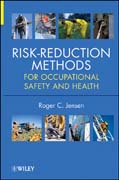
This book covers system safety methods related to occupational health and safety. It argues for anticipating hazards, risk reduction strategies for hazardsprocesses, and making sure workers' tasks correspond to human capabilities. To this end, the text provides pro-active methods for identifying hazards, assessing risk, analyzing hazards, using tools from system safety, conducting post-incident investigations, considering human errors, applying risk reduction strategies, and managing process safety. While emphasizing methods suitable for all countries, it includes references to U.S. military and Department of Energy documents, as well as a discussion of fault-tree construction. INDICE: Preface xiiiAcknowledgments xvPart I: Background 11. Multidisciplinary Perspective 31.1 System Safety Contributions 31.2 Public Health Contributions 61.3 Educational Theory Contributions 7Learning Exercises 9Technical Terms 10References 102. Key Terms and Concepts 132.1 Hazard 132.2 Risk 172.3 Risk Reduction 19Learning Exercises 20Technical Terms 22References 223. Tools for Analysis and Synthesis 253.1 Using Models for Safety Analyses 253.2 Using Charting Methods 283.3 Summary of Part I 33Learning Exercises 34Technical Terms 35References 36Part II: Analysis Methods 374. Analyzing Jobs and Tasks 394.1 Basics of Job Hazard Analysis 394.2 Implementation 434.3 Example JHA 444.4 Hazard Analyses Similar to JHA 45Learning Exercises 47Technical Terms 48References 485. Using Risk-Assessment Methods 495.1 Risk-Assessment Processes 495.2 ExampleRisk Assessment 58Learning Exercises 62Technical Terms 63References 646. Analyzing Failure Modes 656.1 Rationale for FMEA 656.2 Basic FMEA Methodology 656.3 Beyond the Basics 68Learning Exercises 68Technical Terms 69References 697. Constructing Fault Trees 717.1 Introduction to Fault Trees 717.2 Additional Fault Tree Tools 80Learning Exercises 82Technical Terms 83References 848. Analyzing Fault Trees 858.1 Quantitative Analysis Based on Fault Trees 858.2 Identifying Cut Sets 918.3 Finding Common-Cause Failures 958.4 Summary of Part II 97Learning Exercises 98Technical Terms 99References 99Part III: Programmatic Methods for Managing Risk 1019. Incident Investigation Programs 1039.1 Closed-Loop Process 1049.2 Policy Considerations 1059.3 Investigative Processes 1079.4 Practical Tools for Incident Investigators 1109.5 Method for Modeling Harmful Incidents 118Learning Exercises 120Technical Terms 121References 12210. Human Error Reduction 12510.1 Concepts of Errors 12510.2 Comprehensive Classification System 12810.3 Methods for Finding Countermeasures 130Learning Exercises 131Technical Terms 133References 13311. Risk-Reduction Strategies 13511.1 Conceptualizing “Strategies†13511.2 The Nine Strategies 13811.3 Priority for Applying Strategies 142Learning Exercises 143Technical Terms 148References 14812. Common Components of OSH Programs 14912.1 OSH Program Aspirations 14912.2 Training 15012.3 Warnings 15412.4 Safety Devices 15712.5 Emergency Preparedness 15912.6 Sanitation and Housekeeping 162Learning Exercises 163Technical Terms 165References 16613. Tools for Managing OSH Programs 16913.1 Safety Culture 16913.2OSH Management System Approach 17313.3 Ethical Policies for OSH 17513.4 Summary of Part III 177Learning Exercises 178Technical Terms 179Appendix: Example Code of Professional Conduct 179References 180Part IV: Risk Reduction for Energy Sources 18314. Kinetic Energy Hazards 18514.1 Energy in General 18514.2 Background on Kinetic Energy 18714.3 Mechanisms of Harming 19014.4 Strategies and Tactics for Kinetic Energy 193Learning Exercises 198Technical Terms 199References 19915. Electric Energy Hazards 20115.1 Electrical Energy as a Source of Hazard 20115.2 Mechanisms of Harming 20515.3 Strategies and Tactics for Electrical Energy 208Learning Exercises 211Technical Terms 212References 21316. Acoustic Energy and Vibration Hazards 21516.1 Background on Noise and Vibration 21516.2 Mechanisms of Harming 21816.3 Strategies and Tactics for Noise and Vibration 221Learning Exercises 225Technical Terms 228References 22917. Thermal Hazards: Heat and Cold 23117.1 Background on Thermal Hazards 23117.2 Mechanisms of Harming 23717.3 Strategies and Tactics for Thermal Hazards 238Learning Exercises 243Technical Terms 245References 24518. Fire Hazards 24718.1 Fundamentals of Fire 24718.2 Mechanisms of Harming 25318.3 Strategies and Tactics for Fires 254Learning Exercises 259Technical Terms 260References 26119. Explosion Hazards 26319.1 Background on Explosions 26319.2 Mechanisms of Harming 26419.3 Strategies and Tactics for Explosions 265Learning Exercises 270Technical Terms 271References 27120. Pressure Hazards 27320.1 Overview of Pressure Hazards 27320.2Mechanisms of Harming 27520.3 Strategies and Tactics for Pressure-Related Hazards 277Learning Exercises 282Technical Terms 284References 28421. Hazards of Electromagnetic Energies 28521.1 Fundamentals of Electromagnetic Energy 28521.2 Mechanisms of Harming 28821.3 Strategies and Tactics for Electromagnetic Hazards 290Learning Exercises 294Technical Terms 295References 29522. Hazards of Severe Weather and Geological Events 29722.1 Background 29722.2 Mechanisms of Harming 29922.3 Strategies and Tactics for Weather and Geological Events 29922.4 Summary of Part IV 302Learning Exercises 303Technical Terms 303Reference 303Part V: Risk Reduction for Other Than Energy Sources 30523. Workplace Conditions 30723.1 Background 30723.2 Floors 30823.3 Stairways and Steps 31523.4 Ramps 31823.5 Confined Spaces 31923.6 Dusty Air 321Learning Exercises 322TechnicalTerms 323References 32424. Chemical Substances 32724.1 Major Categories of Chemicals Encountered at Work 32724.2 Mechanisms of Harming 32924.3 Strategies and Tactics for Workplace Chemicals 330Learning Exercises 333Technical Terms 333References 33425. Biological Agents 33525.1 Plants 33525.2 Pets 33625.3 Livestock 33625.4 Wild Animals 33725.5 Mold 33825.6 Pathogens 338Learning Exercises341Technical Terms 342References 34226. Musculoskeletal Stressors 34326.1 Background 34326.2 Means by which Musculoskeletal Stressors can Harm 34426.3 Strategies and Tactics for Musculoskeletal Stressors 347Learning Exercises 351Technical Terms 351References 35227. Violent Actions of People 35327.1 Workplace Violence 35327.2 Terrorist Attacks 35727.3 Summary of Part V 358Learning Exercises 359Technical Terms 359References 360Index 361
- ISBN: 978-0-470-88141-5
- Editorial: John Wiley & Sons
- Encuadernacion: Cartoné
- Páginas: 384
- Fecha Publicación: 04/05/2012
- Nº Volúmenes: 1
- Idioma: Inglés
